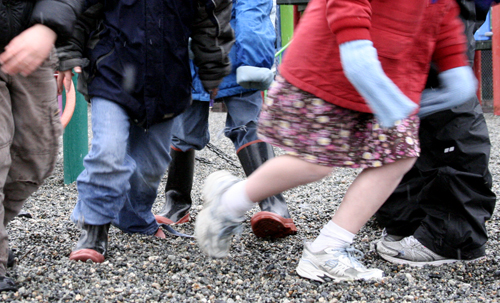From a young age, kids learn how to stay safe. They memorize their phone numbers, learn about stranger danger, and wear helmets when they ride their bikes. But some of the things they learn are more subtle, like to trust their intuition.
In part one of a two-part series, we explored prevention programs in Sitka that aim to build resiliency in young kids through group activities. Now, in part two, we take a look at how lessons learned in childhood might help break the cycle of domestic violence.
We’re in a third grade classroom at Keet Gooshi Heen elementary school. Students are learning about the difference between good and bad touch, a lesson many of us might remember from growing up.
“Who has an idea of what a safe touch might be? Can anybody give me an example? Yeah, so maybe a pat on the back…”
Elena Gustafson is the Youth Outreach coordinator at the local women’s shelter, Sitkans Against Family Violence, or SAFV. She’s teaching a class about personal safety.
“Hugs, high fives, handshakes, pats on the back…how do all of these touches make us feel? They make us feel good. Yeah, they make us feel safe. If you get a high five from somebody, maybe you might feel proud. So these typically make us feel really good,” said Gustafson.
Being a young child can be a confusing time, and life lessons can seem contradictory. Kids are often taught to be polite and respect authority, but also to not talk to strangers. This class focuses on teaching kids to pay attention to how a touch or situation makes them feel.
“An uh oh feeling is a feeling in your tummy that you know something just isn’t right.” Diana Twaddle is a counselor at the elementary school. By having open discussions with kids, the hope is it’ll give children the tools they need to deal with tough situations they may encounter.
“You can always say, ‘no thank you’ to any touch because you are each the bosses of your own bodies,” Gustafson tells the class. “So that means you are in charge of what touches you want and what touches you don’t want.”
Gustafson and Twaddle will visit every classroom at Keet to give a safety talk. They hope that by empowering kids to stand up for themselves, they’re able to decrease violence in future generations. Children who experience trauma are not only much more likely to become the perpetrators or victims of violence, they’re also more likely to develop a slew of other problems later in life.
“Lung disease, and heart disease, and substance abuse issues…smoking, alcoholism, IV drug use, unwanted or teen pregnancy, STDs…”
These ailments are a medical outcome of what most agree is a serious social epidemic. Alaska has one of the highest domestic violence rates in the nation. Nearly half of Alaska’s women have experienced intimate partner violence in their lifetime. That puts the state third, behind Oklahoma and Nevada, but well above the national average of about 36 percent.
While teaching children about boundaries is a critical step in addressing domestic violence, so is enforcing those boundaries later in life.
“If we can get kids out of those households and get their parents to feel like they can safely get out of those households, then we are hopefully ending the problem in the future.”
Christine McLeod Pate is an attorney. She works for the Alaska Network on Domestic Violence and Sexual Assault – a coalition of 18 programs that help abuse victims across the state. The coalition has been running a pro bono program for shelters in Alaska for the last 15 years.
But not everyone who needs legal support can get it. Pate says nearly 200 people apply for legal representation and the network is only able to provide services to about half of them. That leaves 100 people who have to represent themselves in court.
“I think there’s something wrong with the system where you can go to court facing severe safety concerns or facing the potential loss of access to your child and not have a right to an attorney if you can’t afford one,” Pate said.
She says that even if someone isn’t directly affected by domestic violence, everyone pays a steep price. Children who grow up in violent homes often require more help and resources, like special education in schools, extra police protection, and more use of the court system. “This is something that really, if it’s not emotionally affecting you, it’s certainly affecting everybody’s pocketbook.”
Alaska’s governor has made domestic violence a top law enforcement priority, and intervention and education are on the rise in the state — but those delivering the services wonder if it’s enough. Gustafson and Twaddle give a personal safety lesson to each class only once a year at the elementary school. And only half of domestic violence victims in Alaska who seek free legal help can actually get it.
Follow-up studies in rural communities like Sitka may eventually show that early intervention programs work to reduce the rate of domestic violence, but for now it remains a matter of teaching and hoping.
































